Business Functions Report: Analysis of Silver Fern Farms Operations
VerifiedAdded on 2023/01/04
|24
|5710
|42
Report
AI Summary
This report provides a comprehensive analysis of the business functions of Silver Fern Farms (SFF), a multinational company specializing in red meat products. The report delves into key areas such as Human Resource Management (HRM), focusing on motivation theories (Maslow's Hierarchy of Needs) and their application to employee retention strategies. It examines SFF's approach to employee training, including a case study on hand washing procedures. The marketing section explores segmentation, targeting, the marketing mix, and positioning strategies employed by SFF. Additionally, the report discusses the role of technology in SFF's operations, providing examples of technology adoption and the importance of secure data management. Finally, the report touches on accounting and financial aspects of the business. The report is based on secondary sources and aims to provide insights into the operational efficiency and effectiveness of SFF.

1 | P a g e
Business Functions
Name Date Name of the File
Business Functions
Name Date Name of the File
Paraphrase This Document
Need a fresh take? Get an instant paraphrase of this document with our AI Paraphraser
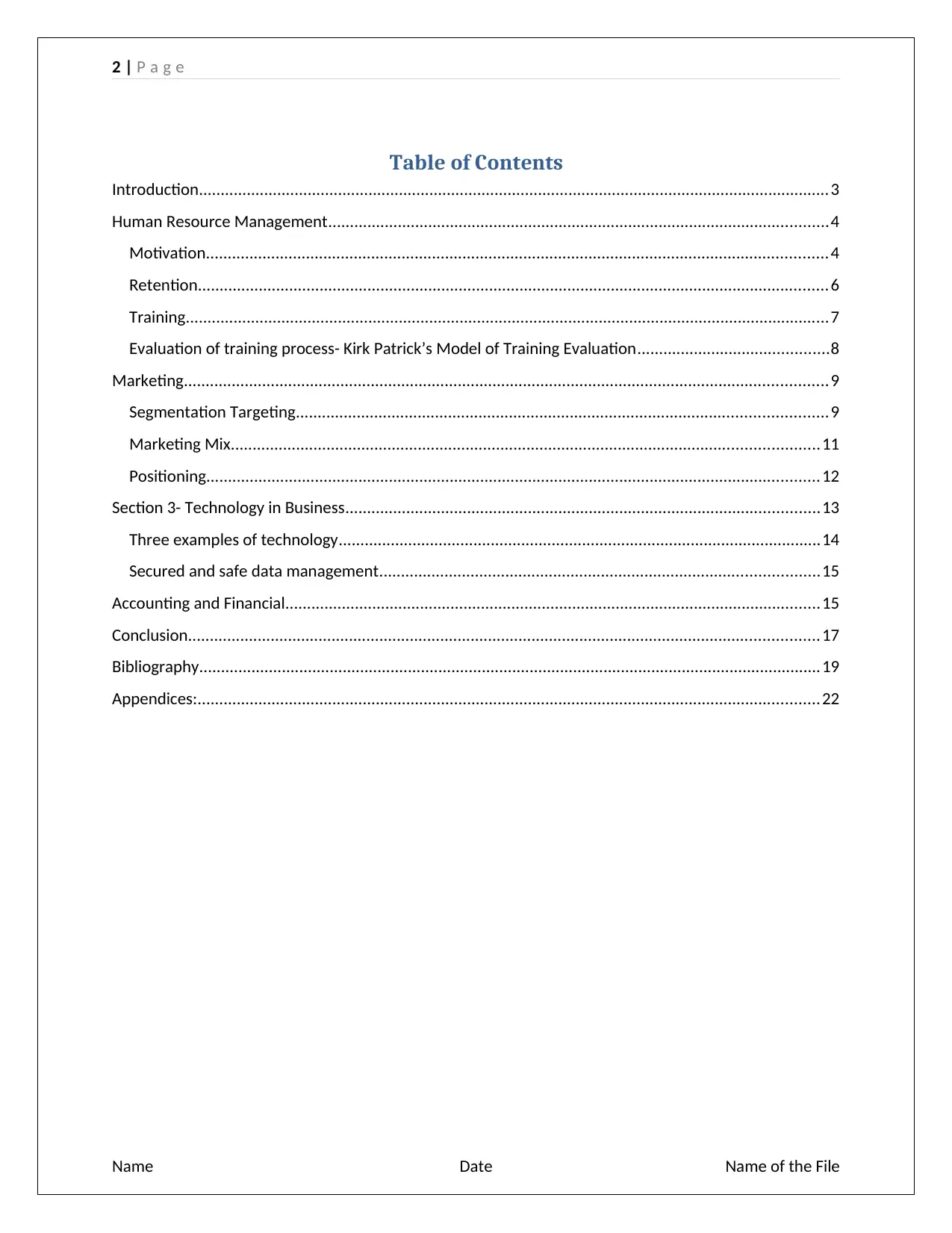
2 | P a g e
Table of Contents
Introduction.................................................................................................................................................3
Human Resource Management...................................................................................................................4
Motivation...............................................................................................................................................4
Retention.................................................................................................................................................6
Training....................................................................................................................................................7
Evaluation of training process- Kirk Patrick’s Model of Training Evaluation............................................8
Marketing....................................................................................................................................................9
Segmentation Targeting..........................................................................................................................9
Marketing Mix.......................................................................................................................................11
Positioning.............................................................................................................................................12
Section 3- Technology in Business.............................................................................................................13
Three examples of technology...............................................................................................................14
Secured and safe data management.....................................................................................................15
Accounting and Financial...........................................................................................................................15
Conclusion.................................................................................................................................................17
Bibliography...............................................................................................................................................19
Appendices:...............................................................................................................................................22
Name Date Name of the File
Table of Contents
Introduction.................................................................................................................................................3
Human Resource Management...................................................................................................................4
Motivation...............................................................................................................................................4
Retention.................................................................................................................................................6
Training....................................................................................................................................................7
Evaluation of training process- Kirk Patrick’s Model of Training Evaluation............................................8
Marketing....................................................................................................................................................9
Segmentation Targeting..........................................................................................................................9
Marketing Mix.......................................................................................................................................11
Positioning.............................................................................................................................................12
Section 3- Technology in Business.............................................................................................................13
Three examples of technology...............................................................................................................14
Secured and safe data management.....................................................................................................15
Accounting and Financial...........................................................................................................................15
Conclusion.................................................................................................................................................17
Bibliography...............................................................................................................................................19
Appendices:...............................................................................................................................................22
Name Date Name of the File
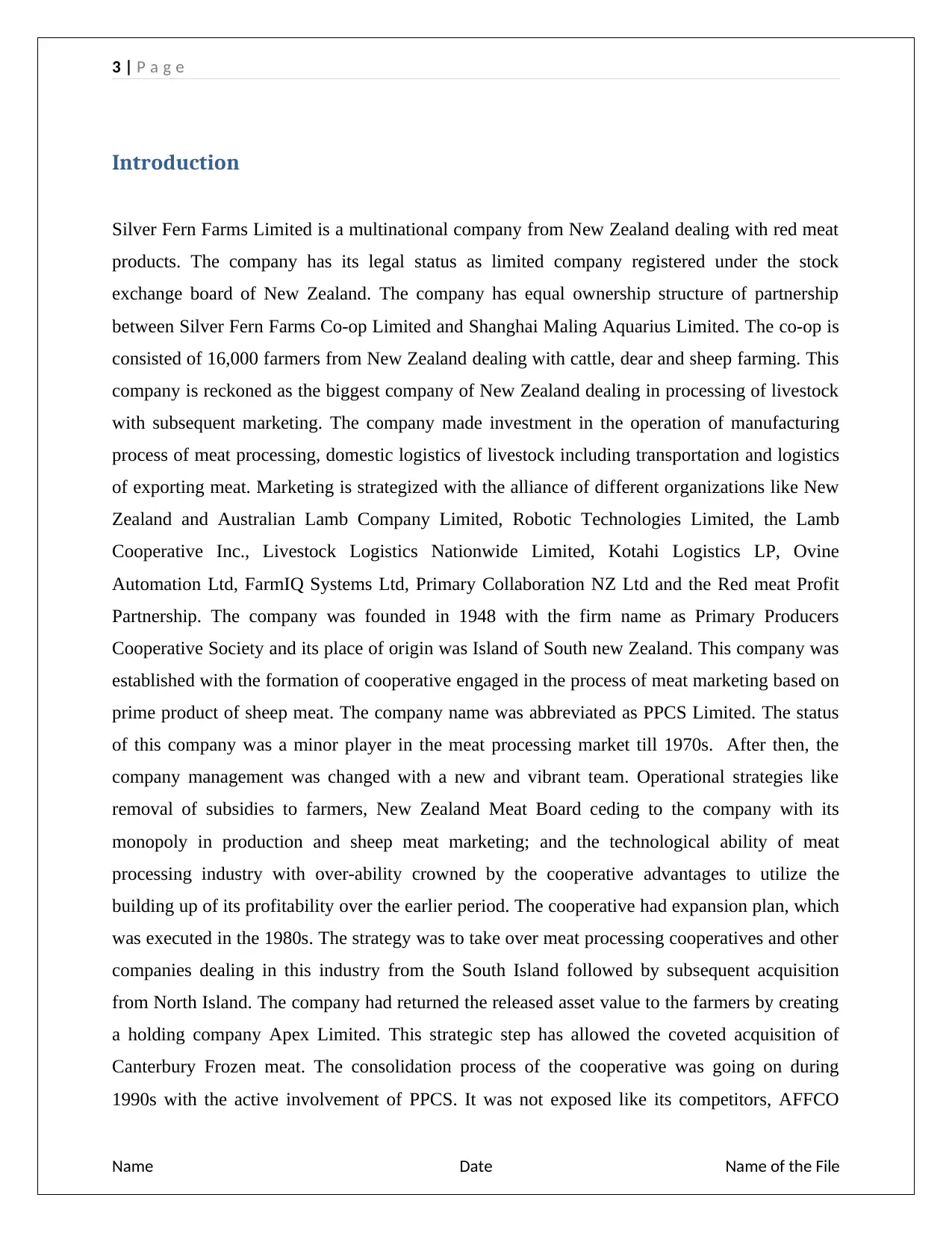
3 | P a g e
Introduction
Silver Fern Farms Limited is a multinational company from New Zealand dealing with red meat
products. The company has its legal status as limited company registered under the stock
exchange board of New Zealand. The company has equal ownership structure of partnership
between Silver Fern Farms Co-op Limited and Shanghai Maling Aquarius Limited. The co-op is
consisted of 16,000 farmers from New Zealand dealing with cattle, dear and sheep farming. This
company is reckoned as the biggest company of New Zealand dealing in processing of livestock
with subsequent marketing. The company made investment in the operation of manufacturing
process of meat processing, domestic logistics of livestock including transportation and logistics
of exporting meat. Marketing is strategized with the alliance of different organizations like New
Zealand and Australian Lamb Company Limited, Robotic Technologies Limited, the Lamb
Cooperative Inc., Livestock Logistics Nationwide Limited, Kotahi Logistics LP, Ovine
Automation Ltd, FarmIQ Systems Ltd, Primary Collaboration NZ Ltd and the Red meat Profit
Partnership. The company was founded in 1948 with the firm name as Primary Producers
Cooperative Society and its place of origin was Island of South new Zealand. This company was
established with the formation of cooperative engaged in the process of meat marketing based on
prime product of sheep meat. The company name was abbreviated as PPCS Limited. The status
of this company was a minor player in the meat processing market till 1970s. After then, the
company management was changed with a new and vibrant team. Operational strategies like
removal of subsidies to farmers, New Zealand Meat Board ceding to the company with its
monopoly in production and sheep meat marketing; and the technological ability of meat
processing industry with over-ability crowned by the cooperative advantages to utilize the
building up of its profitability over the earlier period. The cooperative had expansion plan, which
was executed in the 1980s. The strategy was to take over meat processing cooperatives and other
companies dealing in this industry from the South Island followed by subsequent acquisition
from North Island. The company had returned the released asset value to the farmers by creating
a holding company Apex Limited. This strategic step has allowed the coveted acquisition of
Canterbury Frozen meat. The consolidation process of the cooperative was going on during
1990s with the active involvement of PPCS. It was not exposed like its competitors, AFFCO
Name Date Name of the File
Introduction
Silver Fern Farms Limited is a multinational company from New Zealand dealing with red meat
products. The company has its legal status as limited company registered under the stock
exchange board of New Zealand. The company has equal ownership structure of partnership
between Silver Fern Farms Co-op Limited and Shanghai Maling Aquarius Limited. The co-op is
consisted of 16,000 farmers from New Zealand dealing with cattle, dear and sheep farming. This
company is reckoned as the biggest company of New Zealand dealing in processing of livestock
with subsequent marketing. The company made investment in the operation of manufacturing
process of meat processing, domestic logistics of livestock including transportation and logistics
of exporting meat. Marketing is strategized with the alliance of different organizations like New
Zealand and Australian Lamb Company Limited, Robotic Technologies Limited, the Lamb
Cooperative Inc., Livestock Logistics Nationwide Limited, Kotahi Logistics LP, Ovine
Automation Ltd, FarmIQ Systems Ltd, Primary Collaboration NZ Ltd and the Red meat Profit
Partnership. The company was founded in 1948 with the firm name as Primary Producers
Cooperative Society and its place of origin was Island of South new Zealand. This company was
established with the formation of cooperative engaged in the process of meat marketing based on
prime product of sheep meat. The company name was abbreviated as PPCS Limited. The status
of this company was a minor player in the meat processing market till 1970s. After then, the
company management was changed with a new and vibrant team. Operational strategies like
removal of subsidies to farmers, New Zealand Meat Board ceding to the company with its
monopoly in production and sheep meat marketing; and the technological ability of meat
processing industry with over-ability crowned by the cooperative advantages to utilize the
building up of its profitability over the earlier period. The cooperative had expansion plan, which
was executed in the 1980s. The strategy was to take over meat processing cooperatives and other
companies dealing in this industry from the South Island followed by subsequent acquisition
from North Island. The company had returned the released asset value to the farmers by creating
a holding company Apex Limited. This strategic step has allowed the coveted acquisition of
Canterbury Frozen meat. The consolidation process of the cooperative was going on during
1990s with the active involvement of PPCS. It was not exposed like its competitors, AFFCO
Name Date Name of the File
⊘ This is a preview!⊘
Do you want full access?
Subscribe today to unlock all pages.

Trusted by 1+ million students worldwide

4 | P a g e
Holdings. The acquisition of Richmond Meats made the co-op burdened with debts. Then the co-
op had changed its name as Silver Fern Farms in 2008. Present financial reporting endorses the
profitability of the company with NPAT as $ 15.4 million in 2017. (Farms, nd)
Human Resource Management
Motivation
Motivation is an integral part of human resource management for any organization. Motivation
proves to be the catalyst for getting best output from the employees. It is one of the basic
requirements of leadership trait of the management to motivate their employees for getting the
best result to enhance the performance of the organization. There are different theories of
motivation prevailing in the global corporate level for efficient HRM practice. (White, 2018)
Out of these theories, Abraham Maslow’s Hierarchy of Need Theory will be described with its
respective impact on SFF Co-op Ltd. This theory was evolved by Psychologist Maslow in 1943,
And is popularly used to explain motivational theory for employees. This theory has the pillar of
basic needs of human. As per Maslow, the nature of needs is to be satisfied to get best possible
Name Date Name of the File
Holdings. The acquisition of Richmond Meats made the co-op burdened with debts. Then the co-
op had changed its name as Silver Fern Farms in 2008. Present financial reporting endorses the
profitability of the company with NPAT as $ 15.4 million in 2017. (Farms, nd)
Human Resource Management
Motivation
Motivation is an integral part of human resource management for any organization. Motivation
proves to be the catalyst for getting best output from the employees. It is one of the basic
requirements of leadership trait of the management to motivate their employees for getting the
best result to enhance the performance of the organization. There are different theories of
motivation prevailing in the global corporate level for efficient HRM practice. (White, 2018)
Out of these theories, Abraham Maslow’s Hierarchy of Need Theory will be described with its
respective impact on SFF Co-op Ltd. This theory was evolved by Psychologist Maslow in 1943,
And is popularly used to explain motivational theory for employees. This theory has the pillar of
basic needs of human. As per Maslow, the nature of needs is to be satisfied to get best possible
Name Date Name of the File
Paraphrase This Document
Need a fresh take? Get an instant paraphrase of this document with our AI Paraphraser
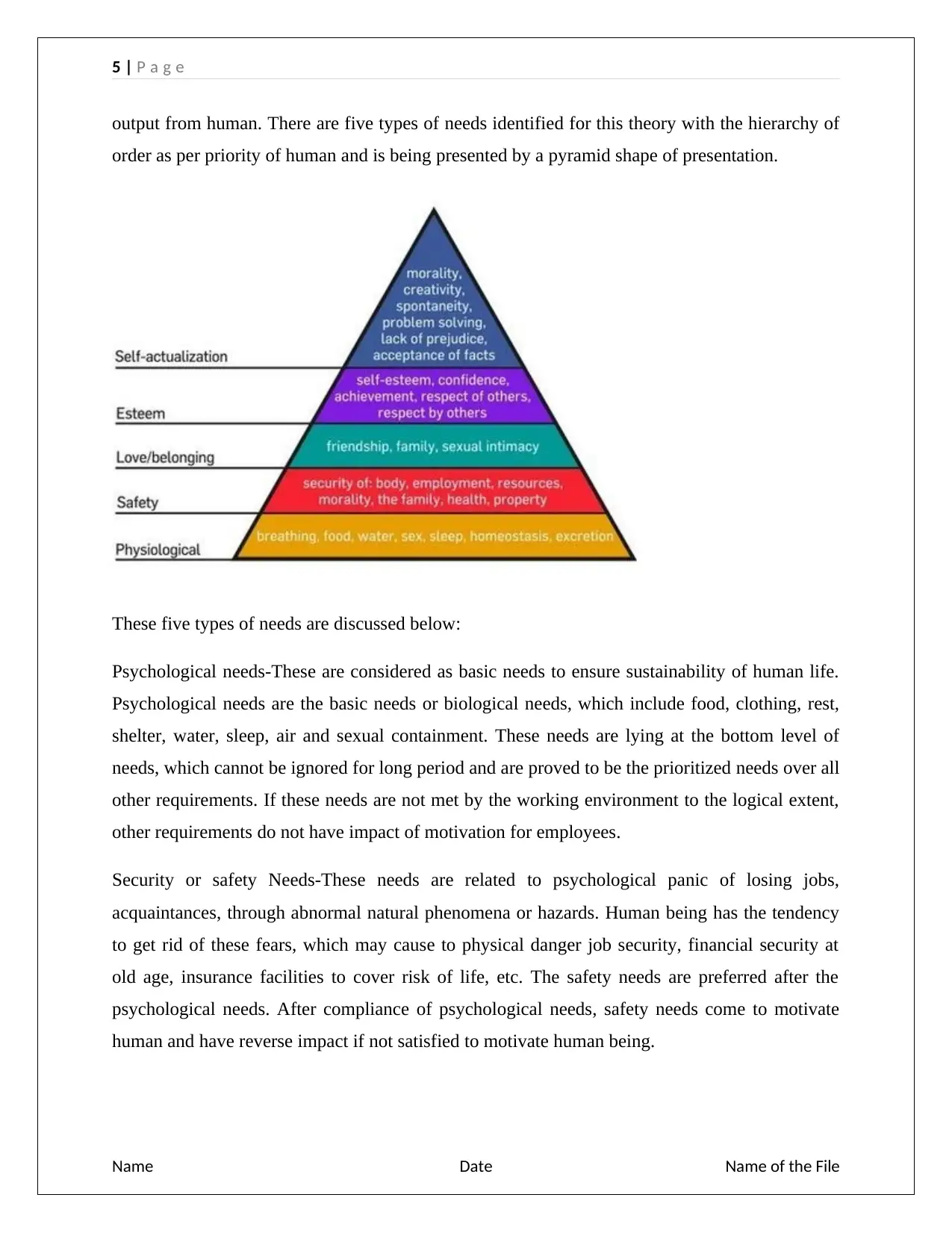
5 | P a g e
output from human. There are five types of needs identified for this theory with the hierarchy of
order as per priority of human and is being presented by a pyramid shape of presentation.
These five types of needs are discussed below:
Psychological needs-These are considered as basic needs to ensure sustainability of human life.
Psychological needs are the basic needs or biological needs, which include food, clothing, rest,
shelter, water, sleep, air and sexual containment. These needs are lying at the bottom level of
needs, which cannot be ignored for long period and are proved to be the prioritized needs over all
other requirements. If these needs are not met by the working environment to the logical extent,
other requirements do not have impact of motivation for employees.
Security or safety Needs-These needs are related to psychological panic of losing jobs,
acquaintances, through abnormal natural phenomena or hazards. Human being has the tendency
to get rid of these fears, which may cause to physical danger job security, financial security at
old age, insurance facilities to cover risk of life, etc. The safety needs are preferred after the
psychological needs. After compliance of psychological needs, safety needs come to motivate
human and have reverse impact if not satisfied to motivate human being.
Name Date Name of the File
output from human. There are five types of needs identified for this theory with the hierarchy of
order as per priority of human and is being presented by a pyramid shape of presentation.
These five types of needs are discussed below:
Psychological needs-These are considered as basic needs to ensure sustainability of human life.
Psychological needs are the basic needs or biological needs, which include food, clothing, rest,
shelter, water, sleep, air and sexual containment. These needs are lying at the bottom level of
needs, which cannot be ignored for long period and are proved to be the prioritized needs over all
other requirements. If these needs are not met by the working environment to the logical extent,
other requirements do not have impact of motivation for employees.
Security or safety Needs-These needs are related to psychological panic of losing jobs,
acquaintances, through abnormal natural phenomena or hazards. Human being has the tendency
to get rid of these fears, which may cause to physical danger job security, financial security at
old age, insurance facilities to cover risk of life, etc. The safety needs are preferred after the
psychological needs. After compliance of psychological needs, safety needs come to motivate
human and have reverse impact if not satisfied to motivate human being.
Name Date Name of the File
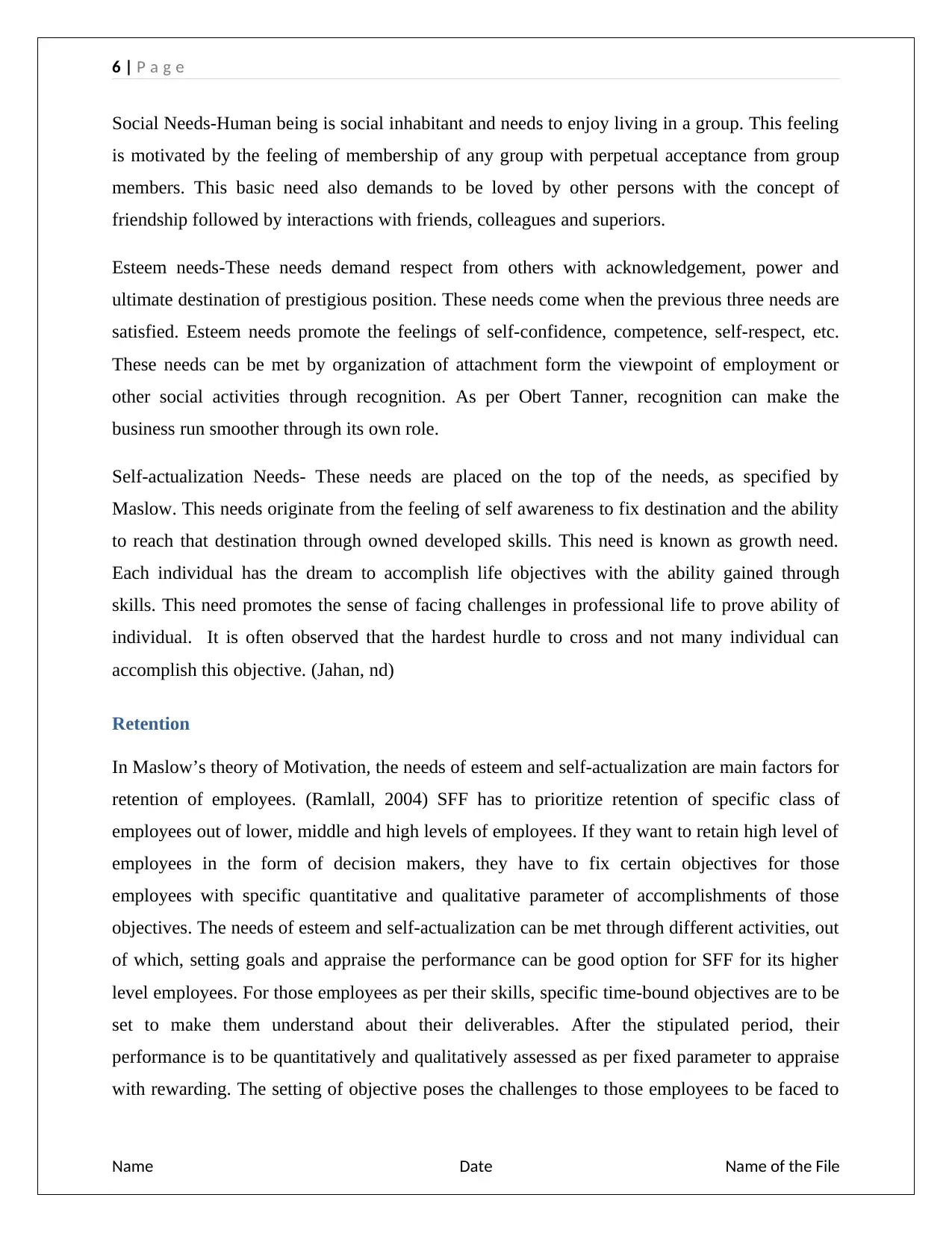
6 | P a g e
Social Needs-Human being is social inhabitant and needs to enjoy living in a group. This feeling
is motivated by the feeling of membership of any group with perpetual acceptance from group
members. This basic need also demands to be loved by other persons with the concept of
friendship followed by interactions with friends, colleagues and superiors.
Esteem needs-These needs demand respect from others with acknowledgement, power and
ultimate destination of prestigious position. These needs come when the previous three needs are
satisfied. Esteem needs promote the feelings of self-confidence, competence, self-respect, etc.
These needs can be met by organization of attachment form the viewpoint of employment or
other social activities through recognition. As per Obert Tanner, recognition can make the
business run smoother through its own role.
Self-actualization Needs- These needs are placed on the top of the needs, as specified by
Maslow. This needs originate from the feeling of self awareness to fix destination and the ability
to reach that destination through owned developed skills. This need is known as growth need.
Each individual has the dream to accomplish life objectives with the ability gained through
skills. This need promotes the sense of facing challenges in professional life to prove ability of
individual. It is often observed that the hardest hurdle to cross and not many individual can
accomplish this objective. (Jahan, nd)
Retention
In Maslow’s theory of Motivation, the needs of esteem and self-actualization are main factors for
retention of employees. (Ramlall, 2004) SFF has to prioritize retention of specific class of
employees out of lower, middle and high levels of employees. If they want to retain high level of
employees in the form of decision makers, they have to fix certain objectives for those
employees with specific quantitative and qualitative parameter of accomplishments of those
objectives. The needs of esteem and self-actualization can be met through different activities, out
of which, setting goals and appraise the performance can be good option for SFF for its higher
level employees. For those employees as per their skills, specific time-bound objectives are to be
set to make them understand about their deliverables. After the stipulated period, their
performance is to be quantitatively and qualitatively assessed as per fixed parameter to appraise
with rewarding. The setting of objective poses the challenges to those employees to be faced to
Name Date Name of the File
Social Needs-Human being is social inhabitant and needs to enjoy living in a group. This feeling
is motivated by the feeling of membership of any group with perpetual acceptance from group
members. This basic need also demands to be loved by other persons with the concept of
friendship followed by interactions with friends, colleagues and superiors.
Esteem needs-These needs demand respect from others with acknowledgement, power and
ultimate destination of prestigious position. These needs come when the previous three needs are
satisfied. Esteem needs promote the feelings of self-confidence, competence, self-respect, etc.
These needs can be met by organization of attachment form the viewpoint of employment or
other social activities through recognition. As per Obert Tanner, recognition can make the
business run smoother through its own role.
Self-actualization Needs- These needs are placed on the top of the needs, as specified by
Maslow. This needs originate from the feeling of self awareness to fix destination and the ability
to reach that destination through owned developed skills. This need is known as growth need.
Each individual has the dream to accomplish life objectives with the ability gained through
skills. This need promotes the sense of facing challenges in professional life to prove ability of
individual. It is often observed that the hardest hurdle to cross and not many individual can
accomplish this objective. (Jahan, nd)
Retention
In Maslow’s theory of Motivation, the needs of esteem and self-actualization are main factors for
retention of employees. (Ramlall, 2004) SFF has to prioritize retention of specific class of
employees out of lower, middle and high levels of employees. If they want to retain high level of
employees in the form of decision makers, they have to fix certain objectives for those
employees with specific quantitative and qualitative parameter of accomplishments of those
objectives. The needs of esteem and self-actualization can be met through different activities, out
of which, setting goals and appraise the performance can be good option for SFF for its higher
level employees. For those employees as per their skills, specific time-bound objectives are to be
set to make them understand about their deliverables. After the stipulated period, their
performance is to be quantitatively and qualitatively assessed as per fixed parameter to appraise
with rewarding. The setting of objective poses the challenges to those employees to be faced to
Name Date Name of the File
⊘ This is a preview!⊘
Do you want full access?
Subscribe today to unlock all pages.

Trusted by 1+ million students worldwide

7 | P a g e
deliver best of their efforts for coveted output, fixed as objective. Coveted accomplishment
always boosts up self esteem of the employees and the scope of retention is fairly good with the
positive impact of recognition through rewarding. It is highlighted in the journal article of
Employee Retention by Motivation by K. Sandhya and D. Pradeep Kumar in December, 2011
published in the Indian Journal of Science and Technology. (Sandhya & Kumar, 2011)
Training
SFF, in their general practice, uses to extend different training programs related to health and
safety tasks. The training programs are consisted of theoretical and practical approaches to
ensure best possible outcome from them for making well-trained employees about the basics of
the jobs allocated to them. I was chosen to conduct a training program on health task of hand
washing. The importance of washing hands are elementary for different reason, out of which, the
preparation of cooking items is one important issue. As the business of SFF demands preparation
and storage of different red meat items, it is essential for the employees in operation to take
proper care about the health and hygiene issue with top priority. One of the most important tasks
related to this job is to wash hands properly with the guidelines provided by the better health
website of Australian Government.
The theoretical approach of experimental learning cycle provides different stages of training. I
have to follow those stages to ensure best possible training namely, experience, reflection and
learning
Experience (Do)- To extend training on the task of hand washing, I have gathered knowledge
from the website better health of Australian Government. (betterhealth, 2015) The guideline
provides to-do tasks in this aspect, which are as follows:
When to wash hands;
How to wash hands properly.
The hands are to be washed after different tasks performed. The task of hand washing is mainly
depending upon the work done or to-be done. Of many situations, there is distinct situation as-
Before, during and after cooking food; and Between handling raw, or cooked or ready to eat
foods. As SFF employees engaged in different meat processing unit, they have to be concerned
Name Date Name of the File
deliver best of their efforts for coveted output, fixed as objective. Coveted accomplishment
always boosts up self esteem of the employees and the scope of retention is fairly good with the
positive impact of recognition through rewarding. It is highlighted in the journal article of
Employee Retention by Motivation by K. Sandhya and D. Pradeep Kumar in December, 2011
published in the Indian Journal of Science and Technology. (Sandhya & Kumar, 2011)
Training
SFF, in their general practice, uses to extend different training programs related to health and
safety tasks. The training programs are consisted of theoretical and practical approaches to
ensure best possible outcome from them for making well-trained employees about the basics of
the jobs allocated to them. I was chosen to conduct a training program on health task of hand
washing. The importance of washing hands are elementary for different reason, out of which, the
preparation of cooking items is one important issue. As the business of SFF demands preparation
and storage of different red meat items, it is essential for the employees in operation to take
proper care about the health and hygiene issue with top priority. One of the most important tasks
related to this job is to wash hands properly with the guidelines provided by the better health
website of Australian Government.
The theoretical approach of experimental learning cycle provides different stages of training. I
have to follow those stages to ensure best possible training namely, experience, reflection and
learning
Experience (Do)- To extend training on the task of hand washing, I have gathered knowledge
from the website better health of Australian Government. (betterhealth, 2015) The guideline
provides to-do tasks in this aspect, which are as follows:
When to wash hands;
How to wash hands properly.
The hands are to be washed after different tasks performed. The task of hand washing is mainly
depending upon the work done or to-be done. Of many situations, there is distinct situation as-
Before, during and after cooking food; and Between handling raw, or cooked or ready to eat
foods. As SFF employees engaged in different meat processing unit, they have to be concerned
Name Date Name of the File
Paraphrase This Document
Need a fresh take? Get an instant paraphrase of this document with our AI Paraphraser
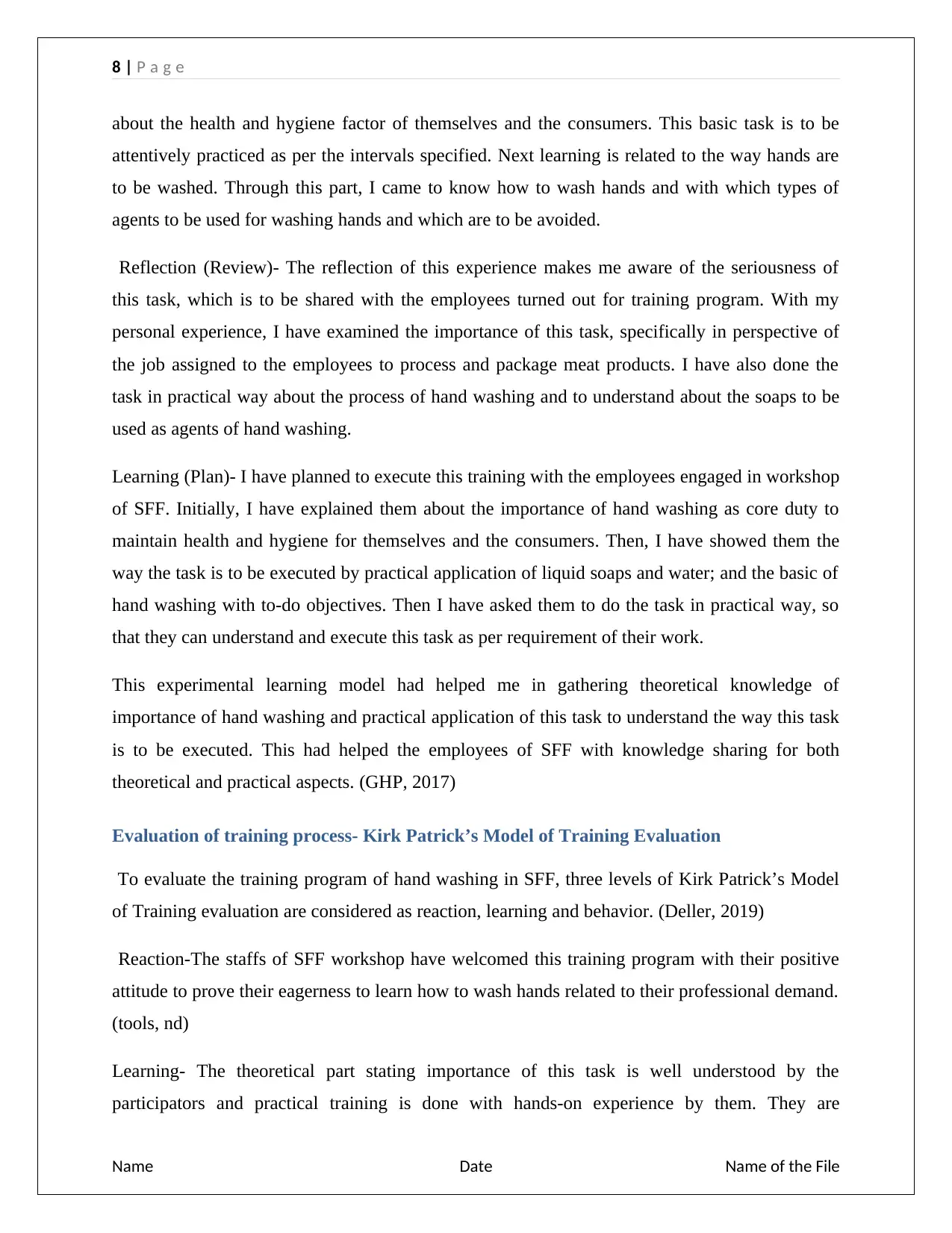
8 | P a g e
about the health and hygiene factor of themselves and the consumers. This basic task is to be
attentively practiced as per the intervals specified. Next learning is related to the way hands are
to be washed. Through this part, I came to know how to wash hands and with which types of
agents to be used for washing hands and which are to be avoided.
Reflection (Review)- The reflection of this experience makes me aware of the seriousness of
this task, which is to be shared with the employees turned out for training program. With my
personal experience, I have examined the importance of this task, specifically in perspective of
the job assigned to the employees to process and package meat products. I have also done the
task in practical way about the process of hand washing and to understand about the soaps to be
used as agents of hand washing.
Learning (Plan)- I have planned to execute this training with the employees engaged in workshop
of SFF. Initially, I have explained them about the importance of hand washing as core duty to
maintain health and hygiene for themselves and the consumers. Then, I have showed them the
way the task is to be executed by practical application of liquid soaps and water; and the basic of
hand washing with to-do objectives. Then I have asked them to do the task in practical way, so
that they can understand and execute this task as per requirement of their work.
This experimental learning model had helped me in gathering theoretical knowledge of
importance of hand washing and practical application of this task to understand the way this task
is to be executed. This had helped the employees of SFF with knowledge sharing for both
theoretical and practical aspects. (GHP, 2017)
Evaluation of training process- Kirk Patrick’s Model of Training Evaluation
To evaluate the training program of hand washing in SFF, three levels of Kirk Patrick’s Model
of Training evaluation are considered as reaction, learning and behavior. (Deller, 2019)
Reaction-The staffs of SFF workshop have welcomed this training program with their positive
attitude to prove their eagerness to learn how to wash hands related to their professional demand.
(tools, nd)
Learning- The theoretical part stating importance of this task is well understood by the
participators and practical training is done with hands-on experience by them. They are
Name Date Name of the File
about the health and hygiene factor of themselves and the consumers. This basic task is to be
attentively practiced as per the intervals specified. Next learning is related to the way hands are
to be washed. Through this part, I came to know how to wash hands and with which types of
agents to be used for washing hands and which are to be avoided.
Reflection (Review)- The reflection of this experience makes me aware of the seriousness of
this task, which is to be shared with the employees turned out for training program. With my
personal experience, I have examined the importance of this task, specifically in perspective of
the job assigned to the employees to process and package meat products. I have also done the
task in practical way about the process of hand washing and to understand about the soaps to be
used as agents of hand washing.
Learning (Plan)- I have planned to execute this training with the employees engaged in workshop
of SFF. Initially, I have explained them about the importance of hand washing as core duty to
maintain health and hygiene for themselves and the consumers. Then, I have showed them the
way the task is to be executed by practical application of liquid soaps and water; and the basic of
hand washing with to-do objectives. Then I have asked them to do the task in practical way, so
that they can understand and execute this task as per requirement of their work.
This experimental learning model had helped me in gathering theoretical knowledge of
importance of hand washing and practical application of this task to understand the way this task
is to be executed. This had helped the employees of SFF with knowledge sharing for both
theoretical and practical aspects. (GHP, 2017)
Evaluation of training process- Kirk Patrick’s Model of Training Evaluation
To evaluate the training program of hand washing in SFF, three levels of Kirk Patrick’s Model
of Training evaluation are considered as reaction, learning and behavior. (Deller, 2019)
Reaction-The staffs of SFF workshop have welcomed this training program with their positive
attitude to prove their eagerness to learn how to wash hands related to their professional demand.
(tools, nd)
Learning- The theoretical part stating importance of this task is well understood by the
participators and practical training is done with hands-on experience by them. They are
Name Date Name of the File
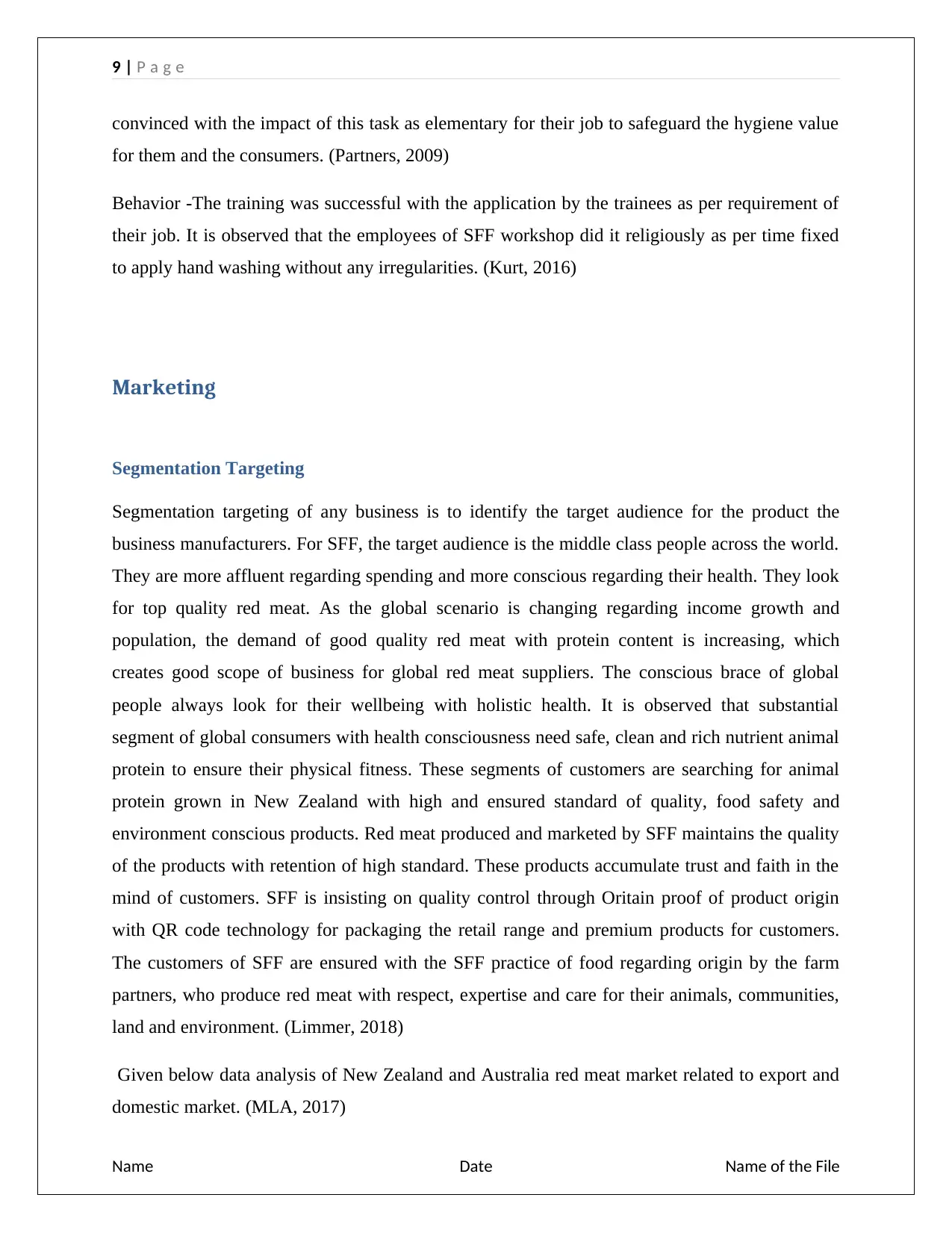
9 | P a g e
convinced with the impact of this task as elementary for their job to safeguard the hygiene value
for them and the consumers. (Partners, 2009)
Behavior -The training was successful with the application by the trainees as per requirement of
their job. It is observed that the employees of SFF workshop did it religiously as per time fixed
to apply hand washing without any irregularities. (Kurt, 2016)
Marketing
Segmentation Targeting
Segmentation targeting of any business is to identify the target audience for the product the
business manufacturers. For SFF, the target audience is the middle class people across the world.
They are more affluent regarding spending and more conscious regarding their health. They look
for top quality red meat. As the global scenario is changing regarding income growth and
population, the demand of good quality red meat with protein content is increasing, which
creates good scope of business for global red meat suppliers. The conscious brace of global
people always look for their wellbeing with holistic health. It is observed that substantial
segment of global consumers with health consciousness need safe, clean and rich nutrient animal
protein to ensure their physical fitness. These segments of customers are searching for animal
protein grown in New Zealand with high and ensured standard of quality, food safety and
environment conscious products. Red meat produced and marketed by SFF maintains the quality
of the products with retention of high standard. These products accumulate trust and faith in the
mind of customers. SFF is insisting on quality control through Oritain proof of product origin
with QR code technology for packaging the retail range and premium products for customers.
The customers of SFF are ensured with the SFF practice of food regarding origin by the farm
partners, who produce red meat with respect, expertise and care for their animals, communities,
land and environment. (Limmer, 2018)
Given below data analysis of New Zealand and Australia red meat market related to export and
domestic market. (MLA, 2017)
Name Date Name of the File
convinced with the impact of this task as elementary for their job to safeguard the hygiene value
for them and the consumers. (Partners, 2009)
Behavior -The training was successful with the application by the trainees as per requirement of
their job. It is observed that the employees of SFF workshop did it religiously as per time fixed
to apply hand washing without any irregularities. (Kurt, 2016)
Marketing
Segmentation Targeting
Segmentation targeting of any business is to identify the target audience for the product the
business manufacturers. For SFF, the target audience is the middle class people across the world.
They are more affluent regarding spending and more conscious regarding their health. They look
for top quality red meat. As the global scenario is changing regarding income growth and
population, the demand of good quality red meat with protein content is increasing, which
creates good scope of business for global red meat suppliers. The conscious brace of global
people always look for their wellbeing with holistic health. It is observed that substantial
segment of global consumers with health consciousness need safe, clean and rich nutrient animal
protein to ensure their physical fitness. These segments of customers are searching for animal
protein grown in New Zealand with high and ensured standard of quality, food safety and
environment conscious products. Red meat produced and marketed by SFF maintains the quality
of the products with retention of high standard. These products accumulate trust and faith in the
mind of customers. SFF is insisting on quality control through Oritain proof of product origin
with QR code technology for packaging the retail range and premium products for customers.
The customers of SFF are ensured with the SFF practice of food regarding origin by the farm
partners, who produce red meat with respect, expertise and care for their animals, communities,
land and environment. (Limmer, 2018)
Given below data analysis of New Zealand and Australia red meat market related to export and
domestic market. (MLA, 2017)
Name Date Name of the File
⊘ This is a preview!⊘
Do you want full access?
Subscribe today to unlock all pages.

Trusted by 1+ million students worldwide

10 | P a g e
Name Date Name of the File
Name Date Name of the File
Paraphrase This Document
Need a fresh take? Get an instant paraphrase of this document with our AI Paraphraser
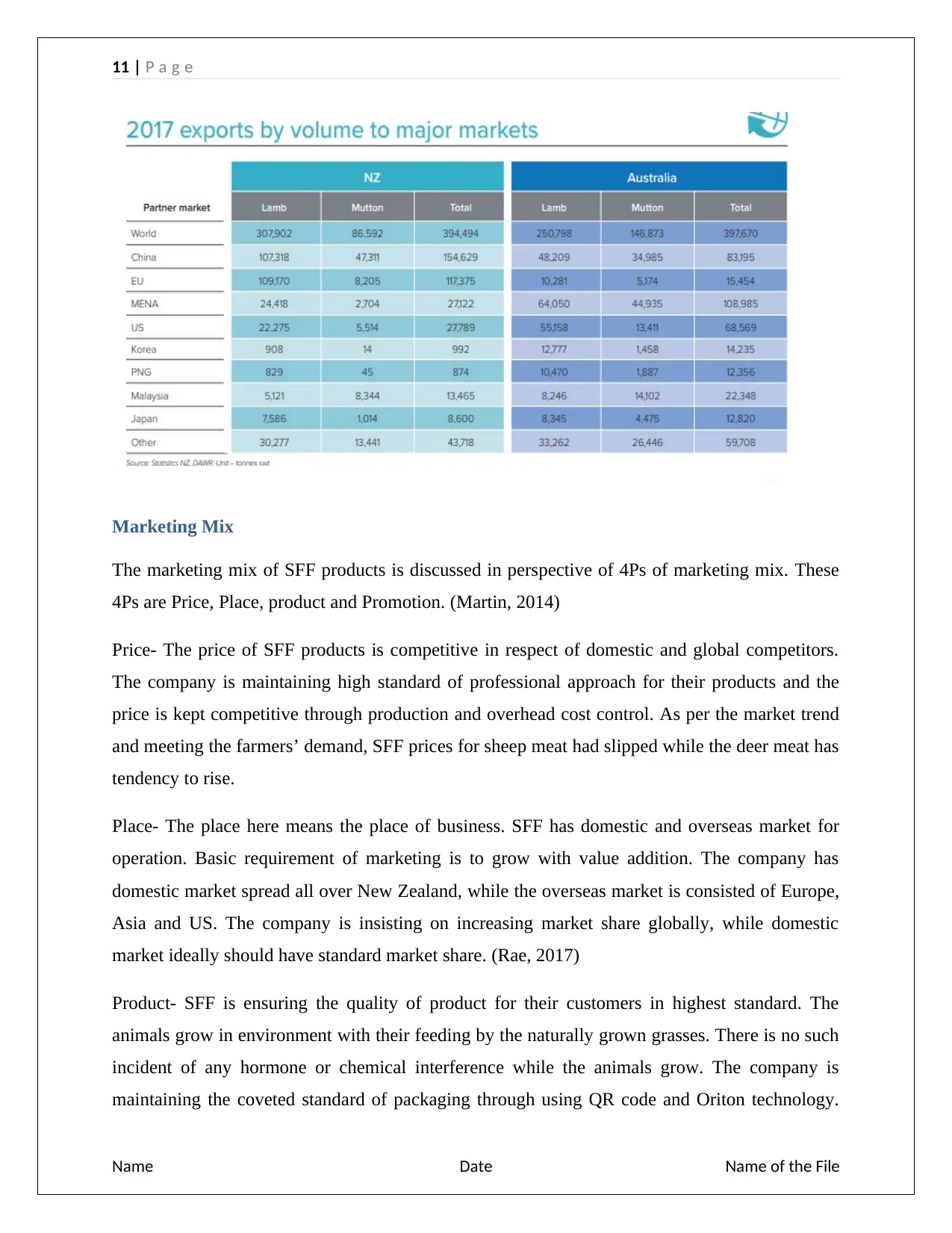
11 | P a g e
Marketing Mix
The marketing mix of SFF products is discussed in perspective of 4Ps of marketing mix. These
4Ps are Price, Place, product and Promotion. (Martin, 2014)
Price- The price of SFF products is competitive in respect of domestic and global competitors.
The company is maintaining high standard of professional approach for their products and the
price is kept competitive through production and overhead cost control. As per the market trend
and meeting the farmers’ demand, SFF prices for sheep meat had slipped while the deer meat has
tendency to rise.
Place- The place here means the place of business. SFF has domestic and overseas market for
operation. Basic requirement of marketing is to grow with value addition. The company has
domestic market spread all over New Zealand, while the overseas market is consisted of Europe,
Asia and US. The company is insisting on increasing market share globally, while domestic
market ideally should have standard market share. (Rae, 2017)
Product- SFF is ensuring the quality of product for their customers in highest standard. The
animals grow in environment with their feeding by the naturally grown grasses. There is no such
incident of any hormone or chemical interference while the animals grow. The company is
maintaining the coveted standard of packaging through using QR code and Oriton technology.
Name Date Name of the File
Marketing Mix
The marketing mix of SFF products is discussed in perspective of 4Ps of marketing mix. These
4Ps are Price, Place, product and Promotion. (Martin, 2014)
Price- The price of SFF products is competitive in respect of domestic and global competitors.
The company is maintaining high standard of professional approach for their products and the
price is kept competitive through production and overhead cost control. As per the market trend
and meeting the farmers’ demand, SFF prices for sheep meat had slipped while the deer meat has
tendency to rise.
Place- The place here means the place of business. SFF has domestic and overseas market for
operation. Basic requirement of marketing is to grow with value addition. The company has
domestic market spread all over New Zealand, while the overseas market is consisted of Europe,
Asia and US. The company is insisting on increasing market share globally, while domestic
market ideally should have standard market share. (Rae, 2017)
Product- SFF is ensuring the quality of product for their customers in highest standard. The
animals grow in environment with their feeding by the naturally grown grasses. There is no such
incident of any hormone or chemical interference while the animals grow. The company is
maintaining the coveted standard of packaging through using QR code and Oriton technology.
Name Date Name of the File
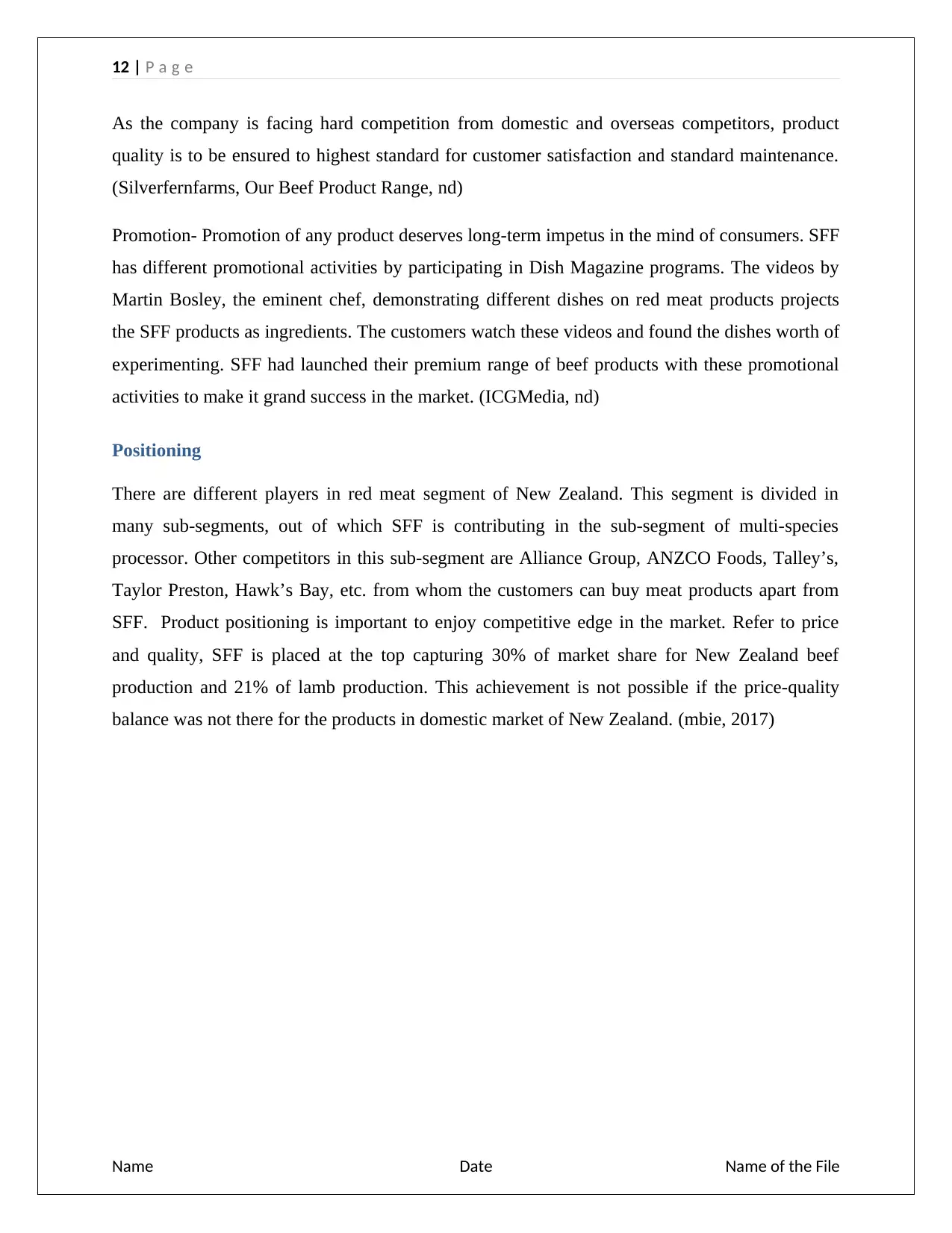
12 | P a g e
As the company is facing hard competition from domestic and overseas competitors, product
quality is to be ensured to highest standard for customer satisfaction and standard maintenance.
(Silverfernfarms, Our Beef Product Range, nd)
Promotion- Promotion of any product deserves long-term impetus in the mind of consumers. SFF
has different promotional activities by participating in Dish Magazine programs. The videos by
Martin Bosley, the eminent chef, demonstrating different dishes on red meat products projects
the SFF products as ingredients. The customers watch these videos and found the dishes worth of
experimenting. SFF had launched their premium range of beef products with these promotional
activities to make it grand success in the market. (ICGMedia, nd)
Positioning
There are different players in red meat segment of New Zealand. This segment is divided in
many sub-segments, out of which SFF is contributing in the sub-segment of multi-species
processor. Other competitors in this sub-segment are Alliance Group, ANZCO Foods, Talley’s,
Taylor Preston, Hawk’s Bay, etc. from whom the customers can buy meat products apart from
SFF. Product positioning is important to enjoy competitive edge in the market. Refer to price
and quality, SFF is placed at the top capturing 30% of market share for New Zealand beef
production and 21% of lamb production. This achievement is not possible if the price-quality
balance was not there for the products in domestic market of New Zealand. (mbie, 2017)
Name Date Name of the File
As the company is facing hard competition from domestic and overseas competitors, product
quality is to be ensured to highest standard for customer satisfaction and standard maintenance.
(Silverfernfarms, Our Beef Product Range, nd)
Promotion- Promotion of any product deserves long-term impetus in the mind of consumers. SFF
has different promotional activities by participating in Dish Magazine programs. The videos by
Martin Bosley, the eminent chef, demonstrating different dishes on red meat products projects
the SFF products as ingredients. The customers watch these videos and found the dishes worth of
experimenting. SFF had launched their premium range of beef products with these promotional
activities to make it grand success in the market. (ICGMedia, nd)
Positioning
There are different players in red meat segment of New Zealand. This segment is divided in
many sub-segments, out of which SFF is contributing in the sub-segment of multi-species
processor. Other competitors in this sub-segment are Alliance Group, ANZCO Foods, Talley’s,
Taylor Preston, Hawk’s Bay, etc. from whom the customers can buy meat products apart from
SFF. Product positioning is important to enjoy competitive edge in the market. Refer to price
and quality, SFF is placed at the top capturing 30% of market share for New Zealand beef
production and 21% of lamb production. This achievement is not possible if the price-quality
balance was not there for the products in domestic market of New Zealand. (mbie, 2017)
Name Date Name of the File
⊘ This is a preview!⊘
Do you want full access?
Subscribe today to unlock all pages.

Trusted by 1+ million students worldwide
1 out of 24
Related Documents
Your All-in-One AI-Powered Toolkit for Academic Success.
+13062052269
info@desklib.com
Available 24*7 on WhatsApp / Email
![[object Object]](/_next/static/media/star-bottom.7253800d.svg)
Unlock your academic potential
Copyright © 2020–2025 A2Z Services. All Rights Reserved. Developed and managed by ZUCOL.




